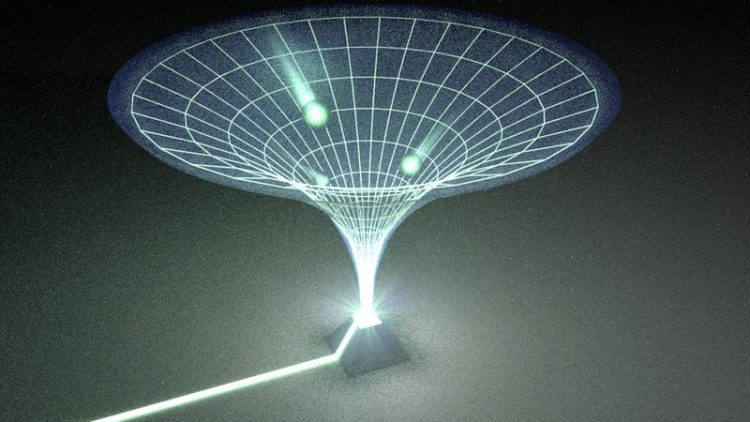Junior scientists at the University of Rostock invent a funnel for light

The schematic illustrates how light get trapped by the funnel. Universität Rostock / Alexander Szameit
The quantum-optical properties of light and its interaction with matter has fascinated the Rostock professor Alexander Szameit since College.
When his graduate students Mark Kremer and Sebastian Weidemann listened to the theoretical visions of Professor Ronny Thomale of Würzburg, none of them would have suspected that the crazy-sounding theoretical concepts discussed during a workshop in Greifswald would culminate in a publication in the prestigious journal Science just six months later.
“A typical research project takes two years to produce and publish its results, sometimes much longer,” explains Alexander Szameit, who was born in Halle and has found his new personal and scientific in Rostock.
Mark Kremer studied physics in Jena, where he first met Szameit, and followed him to the Baltic sea coast for his Ph.D. With his rare combination of theoretical process and experimental skill, he found an ideal scientific partner in Sebastian Weidemann from Stralsund.
As a research team, the two young scientists develop ideas, cross-examine them rigorously and follow their inspiration to its ultimate conclusion. In the months following the fateful workshop, they spent more time in the lab than at home, until they finally came up with an elegant solution how to build a funnel for light: Many kilometers of tightly coiled-up optical fibers.
“These fiber loops allow us to send light on a virtually infinite journey, just like in a traffic roundabout where all exits have suddenly been closed,” describes Kremer. “Then, at the desired point in time, we switch on the ‘funnel’”. Weidemann explains:
“Following the roundabout analogy, we open a single exit, and all the cars race towards it with top speed, regardless of where they were heading before.”
According to the physicists, the surprising fact is that the opening of that exit instantaneously reaches all photons circulating around the loop. Regardless of their location, they all converge towards a single location – just like through a giant funnel.
This mechanism will be particularly useful for optical sensors, as Professor Szameit explains. He is not only happy about the success of his young team, but also values the fruitful collaboration with the “ct.qmat” in Würzburg-Dresden Cluster of Excellence.
His scientific achievements were recently honored with the Tomassoni prize in Italy. Shortly after his return, the entire university of Rostock transitioned to working from home to counter the spread of the Covid-19 pandemic. How social distancing can be maintained when returning to their labs is still a challenge the physicists are trying to solve.
Contact:
Prof. Dr. Alexander Szameit
Experimental Solid State Optics Group
Institute of Physics
Universität Rostock
Phone: +49 381 498-6790
E-Mail: alexander.szameit@uni-rostock.de
The publication in the journal “Science” is available under DOI 10.1126/science.aaz8727.
Media Contact
All latest news from the category: Physics and Astronomy
This area deals with the fundamental laws and building blocks of nature and how they interact, the properties and the behavior of matter, and research into space and time and their structures.
innovations-report provides in-depth reports and articles on subjects such as astrophysics, laser technologies, nuclear, quantum, particle and solid-state physics, nanotechnologies, planetary research and findings (Mars, Venus) and developments related to the Hubble Telescope.
Newest articles

Artificial blood vessels could improve heart bypass outcomes
Artificial blood vessels could improve heart bypass outcomes. 3D-printed blood vessels, which closely mimic the properties of human veins, could transform the treatment of cardiovascular diseases. Strong, flexible, gel-like tubes…

NASA’s Fermi finds new feature in brightest gamma-ray burst yet seen
In October 2022, astronomers were stunned by what was quickly dubbed the BOAT — the brightest-of-all-time gamma-ray burst (GRB). Now an international science team reports that data from NASA’s Fermi…

Folded peptides are more electrically conductive than unfolded peptides
Researchers combined single-molecule experiments, molecular dynamics simulations and quantum mechanics to validate the findings published in PNAS. What puts the electronic pep in peptides? A folded structure, according to a…





















